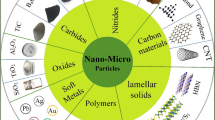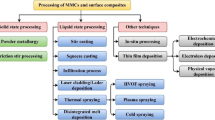Abstract
Tungsten coatings with thickness of 5–500 nm are applied onto plane-faced synthetic diamonds with particle sizes of about 430 and 180 μm. The composition and structure of the coatings are investigated using scanning electron microscopy, X-ray spectral analysis, X-ray diffraction, and atomic force microscopy. The composition of the coatings varies within the range W–W2C–WC. The average roughness, R a, of the coatings’ surfaces (20–100 nm) increases with the weight–average thickness of the coating. Composites with a thermal conductivity (TC) as high as 900 W m−1 K−1 are obtained by spontaneous infiltration, without the aid of pressure, using the coated diamond grains as a filler, and copper or silver as a binder. The optimal coating thickness for producing a composite with maximal TC is 100–250 nm. For this thickness the heat conductance of coatings as a filler/matrix interface is calculated as G = (2–10) × 107 W m−2 K−1. The effects of coating composition, thickness and roughness, as well as of impurities, on wettability during the metal impregnation process and on the TC of the composites are considered.







Similar content being viewed by others
Notes
Here and below TC is considered at temperature about 300 K.
Numbers written with a slash designate the granulometric composition of the powders; in the first case, in meshes, in the second, in micrometers.
Identification by PDF database: 6-675* diamond, cub. lattice; 4-806* W cub.; 35-776* W2C hex.; 25-1047* WC hex.
Optimal for powder diffractography particle size is several µm.
Thermal resistance is determined as ratio ΔT/q, where ΔT (K) is temperature fall, q (W/m2) is heat flow. Inverse to thermal resistance value G = 1/R is called heat conductance and is measured in W m−2 K−1.
References
Shinde SL, Goela JS (eds) (2006) High thermal conductivity materials. Springer, New York
Zweben C (1998) J Miner Met Mater Soc 50:47
Prieto R, Molina JM, Narciso J, Louis E (2008) Scripta Mater 59:11
Kidalov SV, Shakhov FM (2009) Materials 2(4):2467
Gordeev SK, Zhukov SG, Danchukova LV, Ekstrom TC (2001) Neorganicheskie Materialy 37:691 [(2001) Low-pressure fabrication of diamond–SiC–Si composites. Inorg Mater 37:579–583]
Park JS, Sinclair R, Rowcliffe D, Stern M, Davidson H (2006) J Mater Sci 41:4611. doi:10.1007/s10853-006-0249-7
Ruch PW, Beffort O, Kleiner S, Weber L, Uggowitzer PJ (2006) Compos Sci Technol 66:2677
Hanada K, Matsuzaki K, Sano T (2004) J Mater Process Technol 153–154:514
Barcena J, Maudes J, Vellvehi M, Jorda X, Obieta I, Guraya C, Bilbao L, Jimenez C, Merveille C, Coleto J (2008) Acta Astronaut 62:422
Yoshida K, Morigami H (2004) Microelectron Reliab 44:303
Yekimov EA, Suetin NV, Popovich AF, Ralchenko VG, Gromnitskaya EL, Modenov VP (2008) Neorganicheskie Materialy 44:275 [(2008) The influence of microstructures and particle dimensions on the thermal conductivity of diamond composites obtained at high pressures. Inorg Mater 44:224–229]
Weber L, Tavangar R (2007) Scripta Mater 57:988
Weber L, Tavangar R (2009) Adv Mater Res 59:111
Schubert T, Ciupinski L, Zielinski W, Michalski A, Weibgarber T, Kieback B (2008) Scripta Mater 58:263
Schubert T, Trindade B, Weibgarber T, Kieback B (2008) Mater Sci Eng A 475:39
Kerns J, Colella N, Makowiecki D, Davidson H (1995) In: International symposium on microelectronics, Los Angeles, October 24–26, 1995. http://www.osti.gov/bridge/purl.cover.jsp?purl=/112941-Ymk33a/webviewable/
Kerns J, Colella N, Makowiecki D, Davidson H (1996) Int J Microcircuits Electron Packag 19:206
Chu K, Liu Z, Jia C, Chen H, Liang X, Gao W, Tian W, Guo H (2010) J Alloys Compd 490:453
Xia Y, Song Y, Lin C, Cui S, Fang Z (2009) Trans Nonferrous Met Soc China 19:1161
Novikov NV, Gontar’ AG (1990) In: Kvaskov VB (ed) Almaz v elektronnoi tehnike. Energoatomizdat, Moskow (in Russian) [Application of synthetic diamonds in electronics. In: Diamond in electronic technology]
Abyzov AM, Kidalov SV, Shakhov FM (2008) Materialovedenie 5:24 [(2008) Composite material of diamond-copper with high thermal conductivity. Mater Sci Trans 5:24–27]
Tavangar R, Molina JM, Weber L (2007) Scripta Mater 56:357
Chuprina VG (1992) Poroshkovaya Metallurgiya 7:34 [(1992) Physicochemical interaction and structure development during the formation of metal gas-transfer coatings on diamond (review). I. Kinetics. Powder Metall Met Ceram 31(7):578–583]
Chuprina VG (1992) Poroshkovaya Metallurgiya 8:57 [(1992) Physicochemical interaction and structure development during the formation of metal gas-transport coatings on diamond (review). II. Mechanism. Powder Metall Met Ceram 31(8):687–692]
Osintsev OE, Fedorov VN (ed) (2004) Med’ i mednye splavy. Mashinostroenie, Moskow (in Russian) [Copper and copper alloys]
International Tables for Crystallography (2006) vol C, chapt 4.2
Kunii D, Levenspiel O (1969) Fluidization engineering. Wiley, New York
Novikov NV (ed) (1987) Fizicheskie svoistva almaza. Naukova dumka, Kiev (in Russian) [Physical properties of diamond]
Naidich YuV (ed) (1991) Poverhnostnye svoistva rasplavov i tverdyh tel I ih ispol’zovanie v materialovedenii. Naukova dumka, Kiev (in Russian) [Surface properties of melts and solids and their application in materials technology]
Naidich YuV, Lavrinenko IA, Evdokimov VA (1974) Poroshkovaya Metallurgiya 1:34 [(1974) Densification in liquid phase sintering under pressure in the system tungsten-copper. Powder Metall Met Ceram 13(1):26–30]
Kosolapova TYa (ed) (1986) Svoistva, poluchenie i primenenie tugoplavkih soedinenii. Metallurgiya, Moskow (in Russian) [Properties, making and application of refractory substances]
Mortimer DA, Nicholas M (1973) J Mater Sci 8:640. doi:10.1007/BF00561219
Grigor’ev IS, Meilihov EZ (eds) (1991) Fizicheskie velichiny. Energoatomizdat, Moskow (in Russian) [Physical quantities]
Cardarelli F (2008) Materials handbook, chap 3. Springer, London, p 10
Eremenko VN, Minakova RV, Churakov MM (1977) Poroshkovaya Metallurgiya 4:53 [(1977) Solubility of tungsten in copper-nickel melts. Powder Metall Met Ceram 16(4):283–286]
Abrikosov NH (ed) (1979) Dvoinye i mnogokomponentnye sistemy na osnove medi. Nauka, Moskow (in Russian) [Binary and multicomponent systems on the copper basis]
Dorfman S, Fuks D, Suery M (1999) J Mater Sci 34:77. doi:10.1023/A:1004461423717
Bhushan B (2007) In: Bhushan B (ed) Springer handbook of nanotechnology. Springer, Berlin Heidelberg
Yang B, Chen G (2004) In: Tritt T (ed) Thermal conductivity: theory, properties and applications. Kluwer Academic/Plenum Publishers, New York
Feng B, Li Z, Zhang X (2009) Thin Solid Films 517:2803
Efimov VB, Mezhov-Deglin LP (1999) Physica B 263–264:745
Naidich YuV, Kostyuk BD, Kolesnichenko GA, Shaikevich SS (1973) Poroshkovaya Metallurgiya 12:55 [(1973) Adhesion properties and wetting by molten metals of thin metallic films applied to nonmetallic materials. Powder Metall Met Ceram 12(12):988–993]
Naidich YuV, Volk GP, Lavrinenko IA (1981) Poroshkovaya Metallurgiya 9:22 [(1981) Infiltration of metal-coated diamond powders by molten metal. Powder Metall Met Ceram 20(9):610–612]
Marmur A (2009) Annu Rev Mater Res 39:473
Nicholas M, Poole DM (1967) J Mater Sci 2:269. doi:10.1007/BF00555384
Kornilov II, Glazova VV (1967) Vzaimodeistvie tugoplavkih metallov perehodnyh grupp s kislorodom. Nauka, Moskow (in Russian) [Interaction of refractory metals of transition groups with oxygen]
Hasselman DPH, Johnson LF (1987) J Compos Mater 21:508
Acknowledgements
Authors express their appreciation to E.A. Sosnov (St.Petersburg State Institute of Technology) for AFM analysis. Partly this study (S.V. Kidalov and F.M. Shakhov) was supported by the Russian Foundation for Basic Research (RFBR) grant 09-08-01200-a.
Author information
Authors and Affiliations
Corresponding author
Rights and permissions
About this article
Cite this article
Abyzov, A.M., Kidalov, S.V. & Shakhov, F.M. High thermal conductivity composites consisting of diamond filler with tungsten coating and copper (silver) matrix. J Mater Sci 46, 1424–1438 (2011). https://doi.org/10.1007/s10853-010-4938-x
Received:
Accepted:
Published:
Issue Date:
DOI: https://doi.org/10.1007/s10853-010-4938-x




